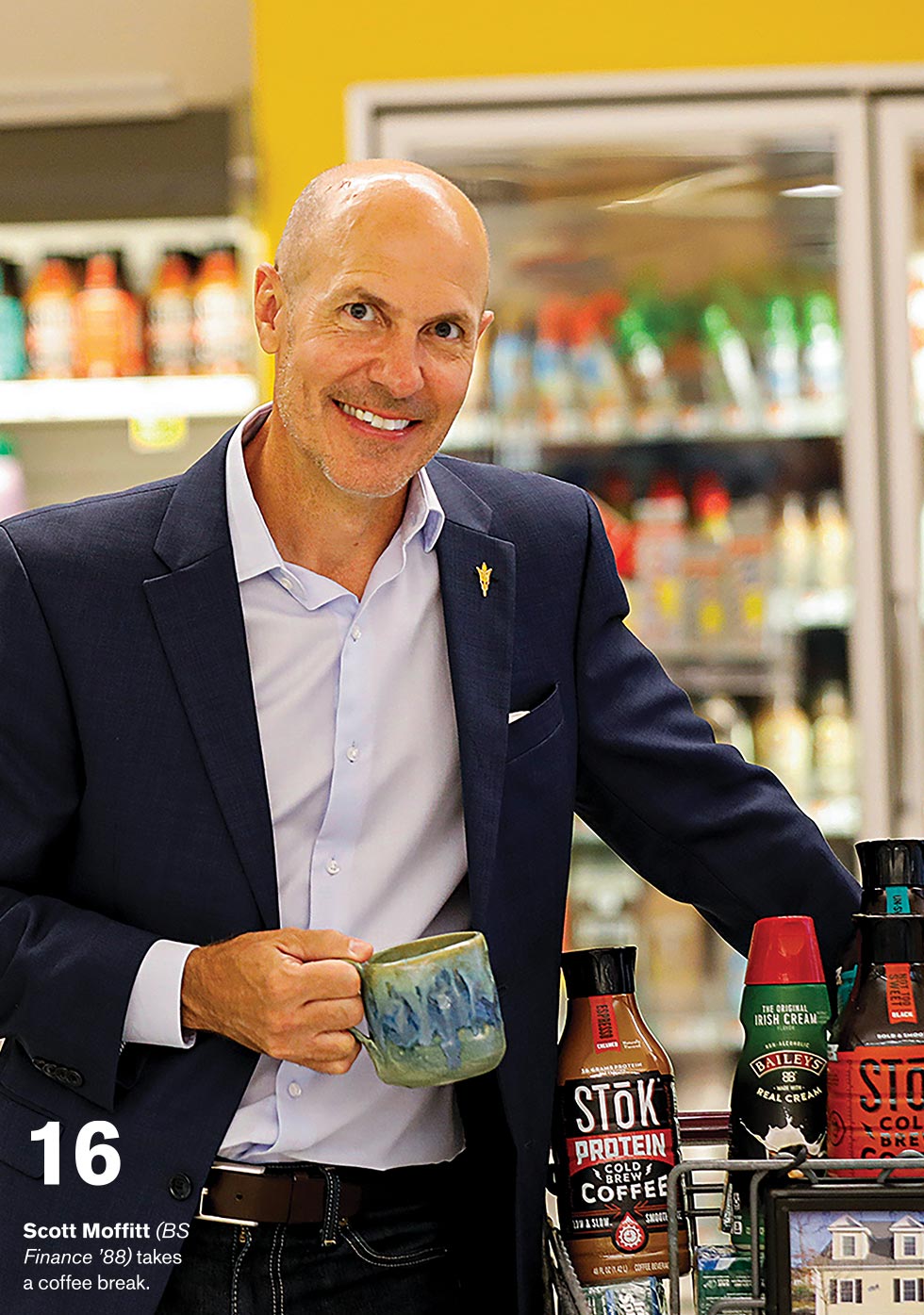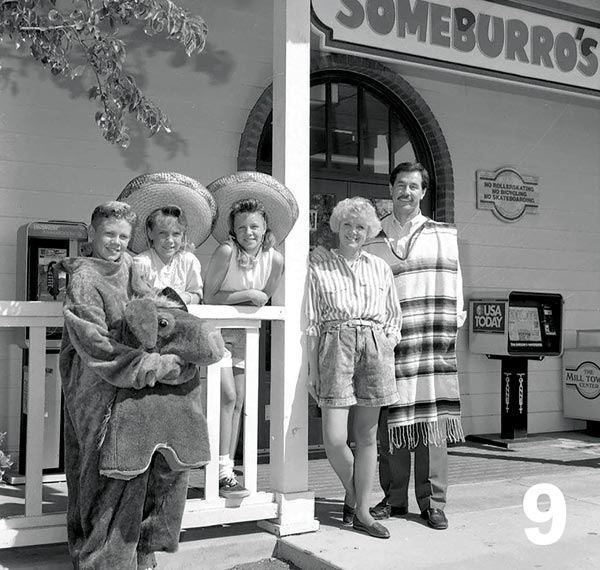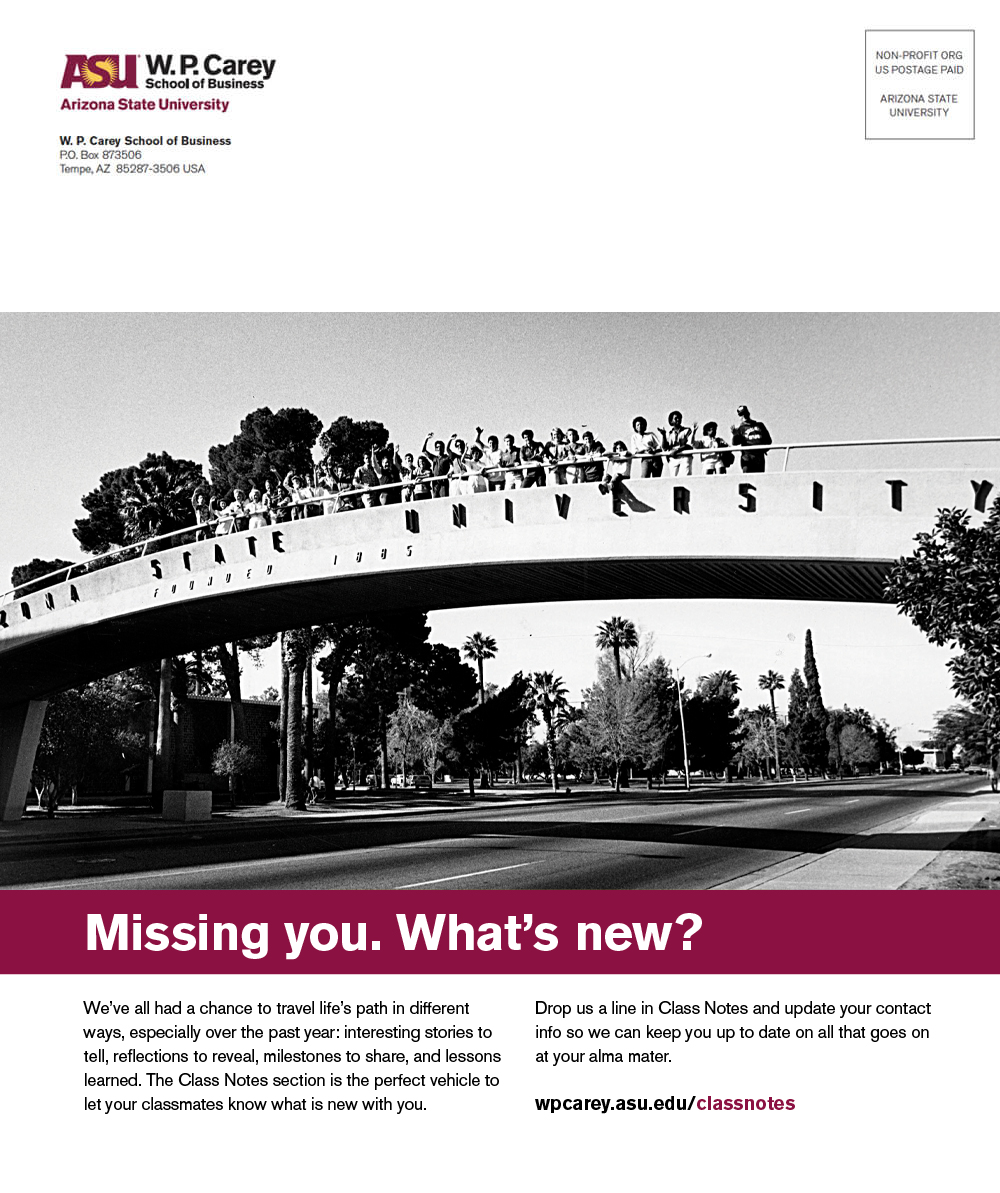
— John Dewey
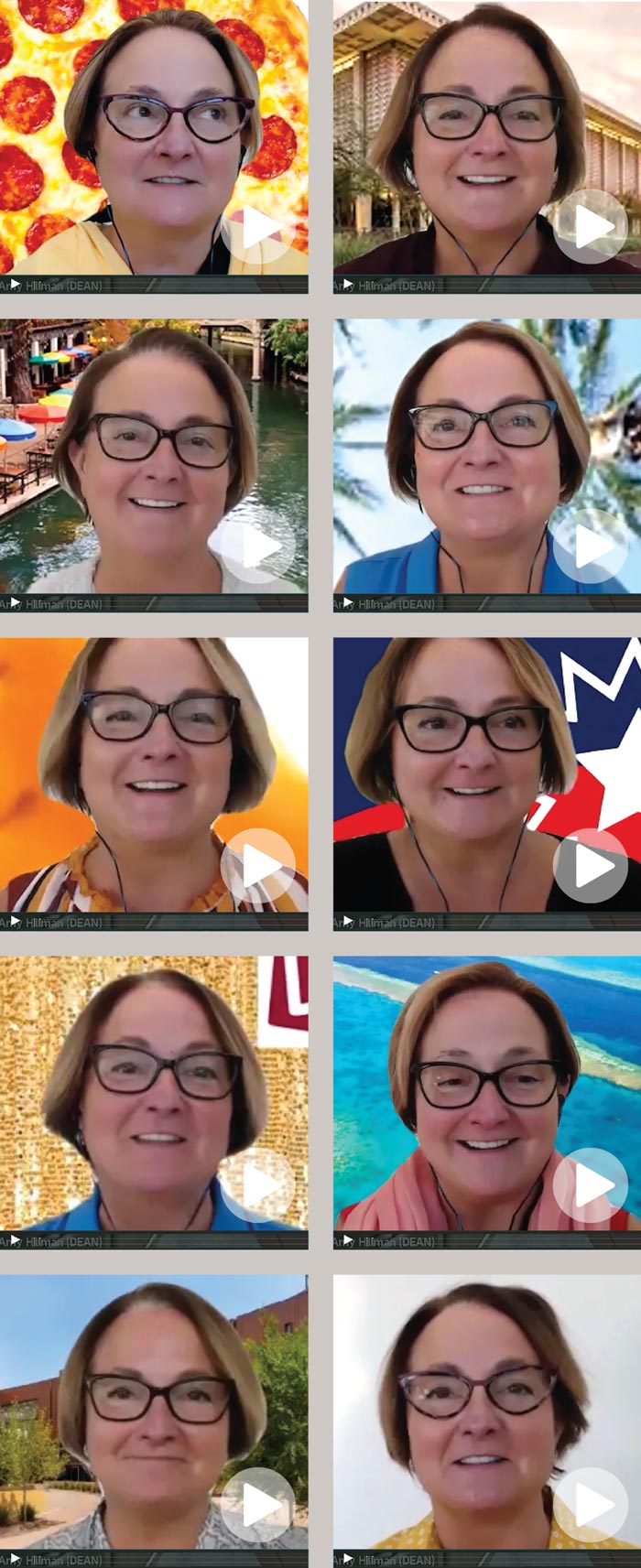
efore anything else, I hope you and your loved ones are remaining healthy during the COVID-19 pandemic. I’m writing this a few weeks before the reopening of the ASU campus on Aug. 20, but we’re excited for the first day and all the advancements we’ve made to be digitally resilient and provide a safe learning environment. This issue focuses on “the new normal,” and our approach to teaching and learning amid constant change.
I also can identify with an idea we raise in one of our features here about learning new habits. I had a plate installed to fix a broken clavicle last week, and I’m constantly impressed by how even this old body is healing while I’m learning new ways to deal with limitations. My outpatient surgery experience was nothing at all like the days pre-COVID-19. I was impressed by the innovative products and procedures that gave me confidence as a patient and put my health care providers’ safety at the forefront.
These challenging times — including global tensions between nations, abuse of power within countries, and strife between beliefs — are ones of stress but also innovation. Entire new industries and uses for old equipment have emerged. Some small businesses have thrived by adaptation while others have failed. The same is true for large organizations — and the W. P. Carey School of Business is no exception. You’ll see areas where we’re pushing the boundaries of disruption. Not all will succeed, but each will help us learn and improve. We’re embracing change and disruption by trying to disrupt ourselves.
Is this risk-taking? You bet it is. But it’s also grounded in our “business is personal” motto where we will do our very best to face what comes humanely and with an absolute focus on each individual. Our innovation also is grounded in the daily obsession of improving the value of the degrees and lives of our students and alumni.
You’ll see a lot more innovation by the time you receive this magazine and I hope you have ideas to help us, too. Please share them with me at amy.hillman@asu.edu.
Go Devils!
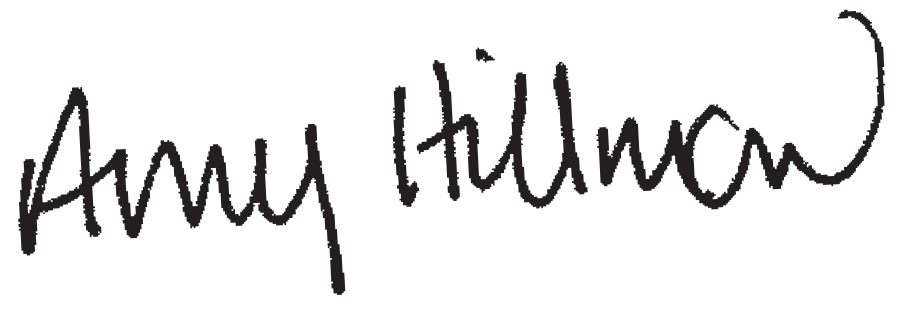
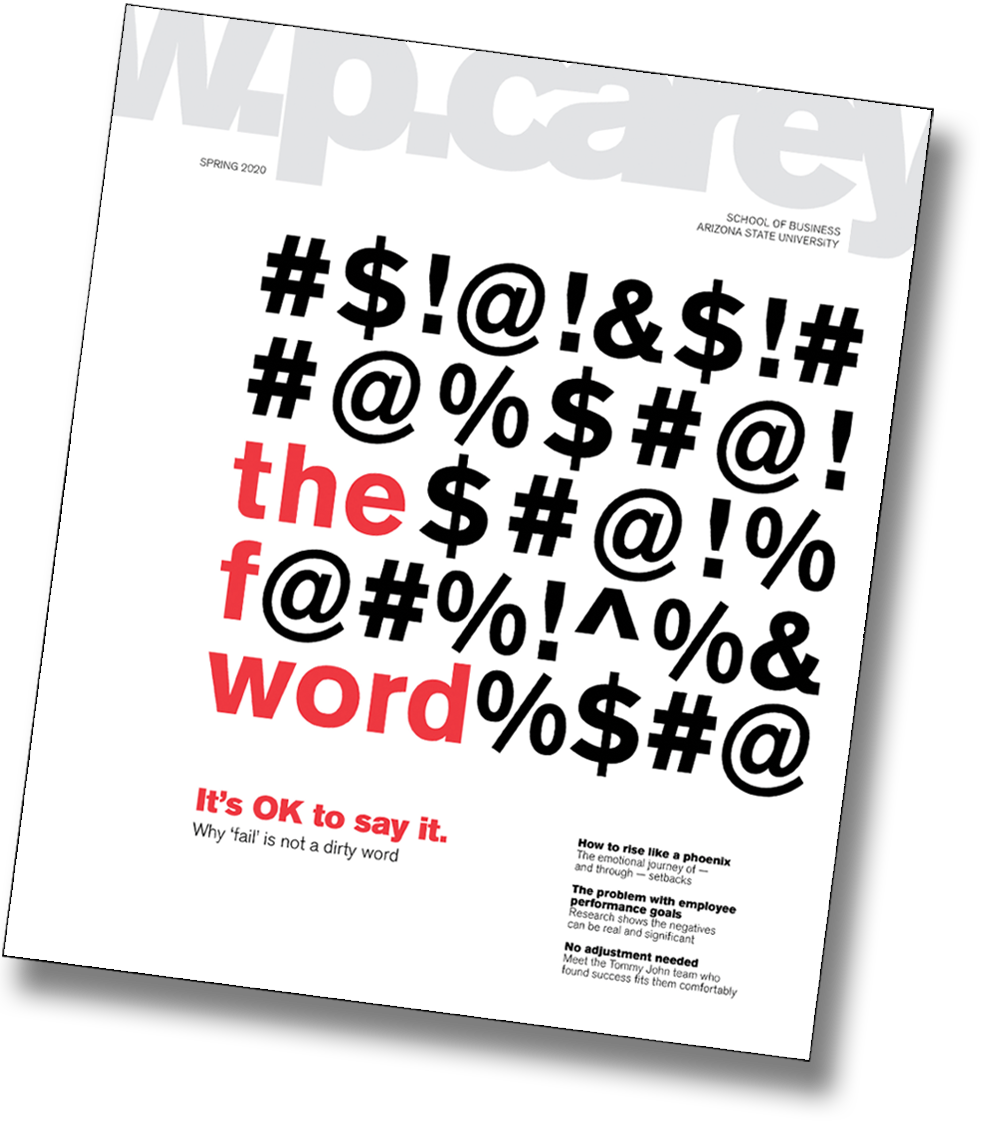
I just got the W. P. Carey magazine in the mail. I used to be an art director for a few different magazines. I truly like the cover, good work on the magazine.
Matt Gunson (MBA ’11)
Dear editor,
As an ASU graduate and entrepreneur, I just wanted to let you know how well done and informative the issue featuring the “F-word” is. Having taught 12 semesters of entrepreneurship classes at Yavapai College in Prescott, Arizona, it remains alarming the number of students who don’t understand the contribution that failure makes toward one’s success.
Warren Tracy (BS Economics ’86)

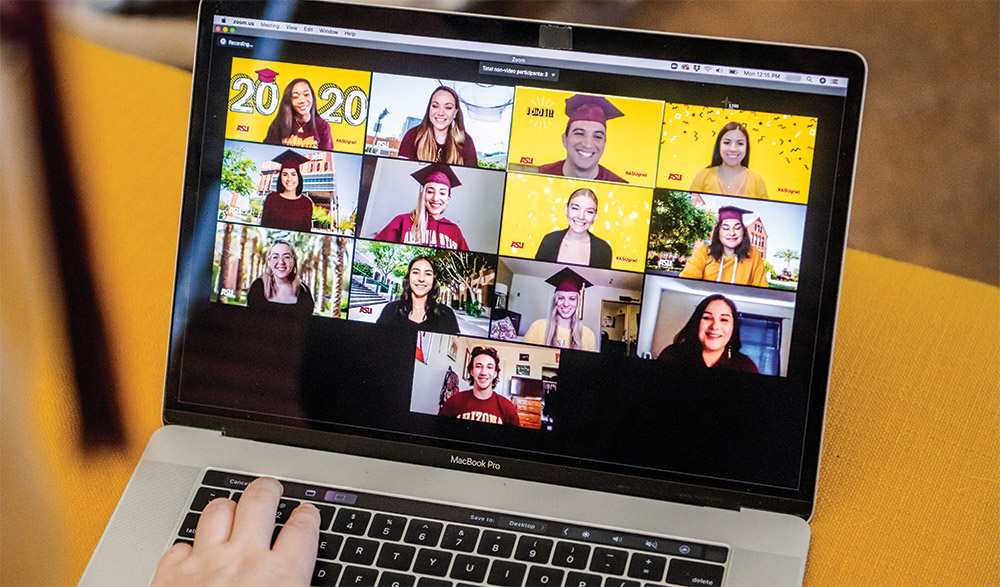
We have found our “reason for being” for each other: using our strengths and passions, as well as our collective love and friendship, to give each other what we need to keep this community strong.

Volume 8, Issue 1, Autumn 2020
Dean
Amy Hillman
Associate Dean, Graduate Programs and External Relations
Kim Steinmetz
Director of Alumni Relations
Brennan Forss
Manager of Alumni Relations
Theresa Shaw
W. P. Carey Alumni
wpcarey.asu.edu/alumni
Facebook
facebook.com/wpcareyschool
LinkedIn
wpcarey.asu.edu/linkedin
Twitter
@WPCareySchool
Shay Moser
Creative Director
Paula Murray
Staff Contributors
Emily Beach, Colin Boyd, Perri Collins, Jane Lee, Ada Malcioln Martin, Tiana Morgan, Hannah O’Regan, Madeline Sargent, Nina Vasan
Contributors
Joe Bardin, Betsy Loeff, Alexander Gelfand, Erin Peterson
Photographers
W. Scott Mitchell, Michael Paras, Shelley Valdez
Managing Editor
W. P. Carey School of Business
Arizona State University
PO Box 872506
Tempe, AZ 85287-2506
Changes of address and other subscription inquiries can be emailed to:
editor.wpcmagazine@asu.edu
W. P. Carey magazine is a publication of the W. P. Carey School of Business at Arizona State University © 2020
Send editorial submissions and letters to:
editor.wpcmagazine@asu.edu

A pioneering master’s degree developed and delivered by ASU’s highly ranked schools of design, engineering, and business, the Master of Science in Innovation and Venture Development (MS-IVD) is looking for ambitious, bold, creative thinkers with an insatiable desire to start something that makes a difference in the world.
- Fills in blanks that most entrepreneurship programs miss
- Designed for innovators and founders
- Ready when you are: wpcarey.asu.edu/ms-ivd

ast fall, Republic Services challenged 36 graduate students from the W. P. Carey School of Business and Herberger Institute for Design and the Arts to envision a 21st-century garbage truck of the future.
Teams of design and business students worked together to ensure their concepts met engineering requirements and were economically feasible. At the end of the project, the students pitched their ideas to Republic Services, one of the nation’s largest recycling and waste disposal companies.
“It was a terrific program, and the students gave us some interesting results,” says Brett Beitzel, Republic’s director of fleet and asset management. The company plans to evaluate the ideas and include them as part of its strategic technology roadmap.
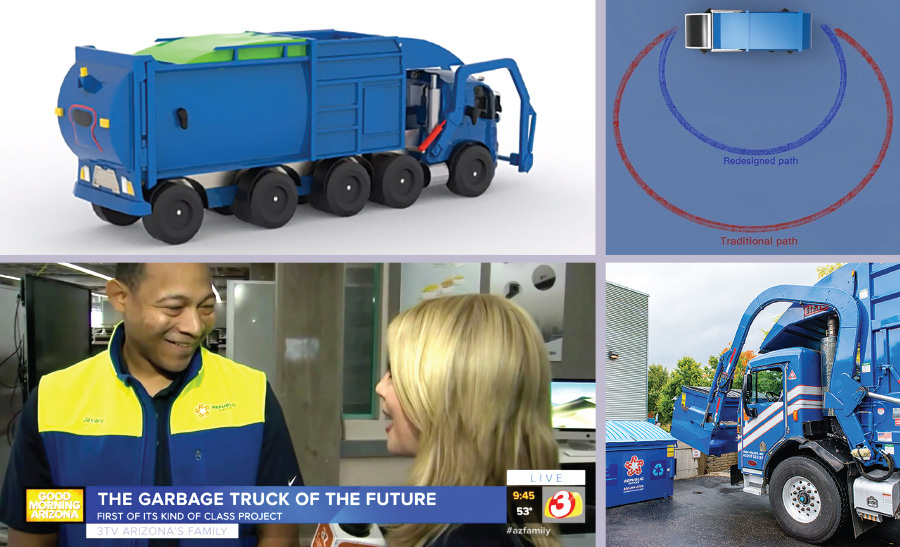
ALL THINGS WPC
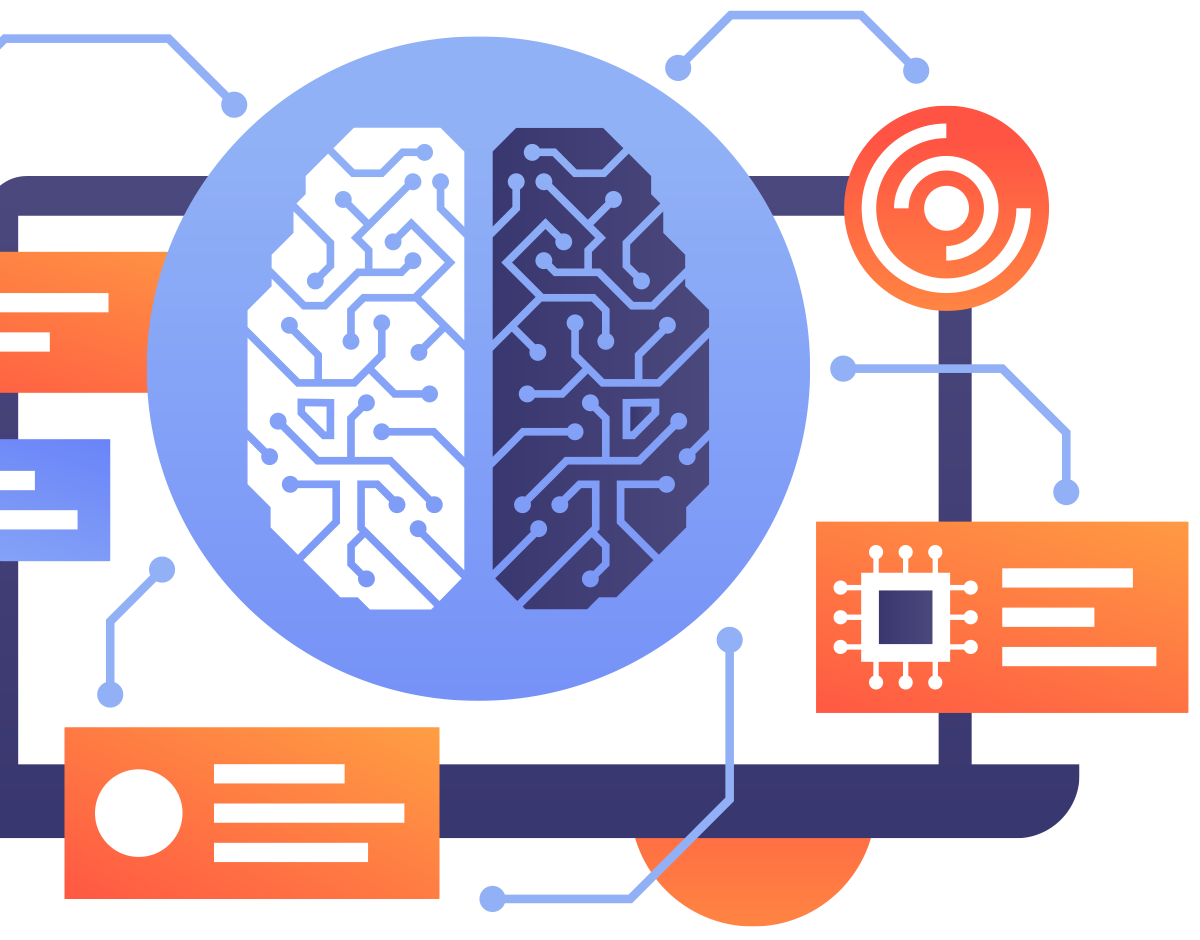
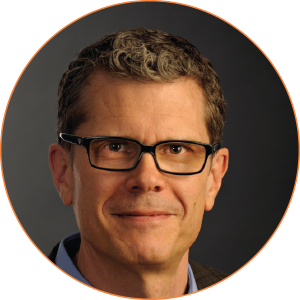
ALL THINGS WPC
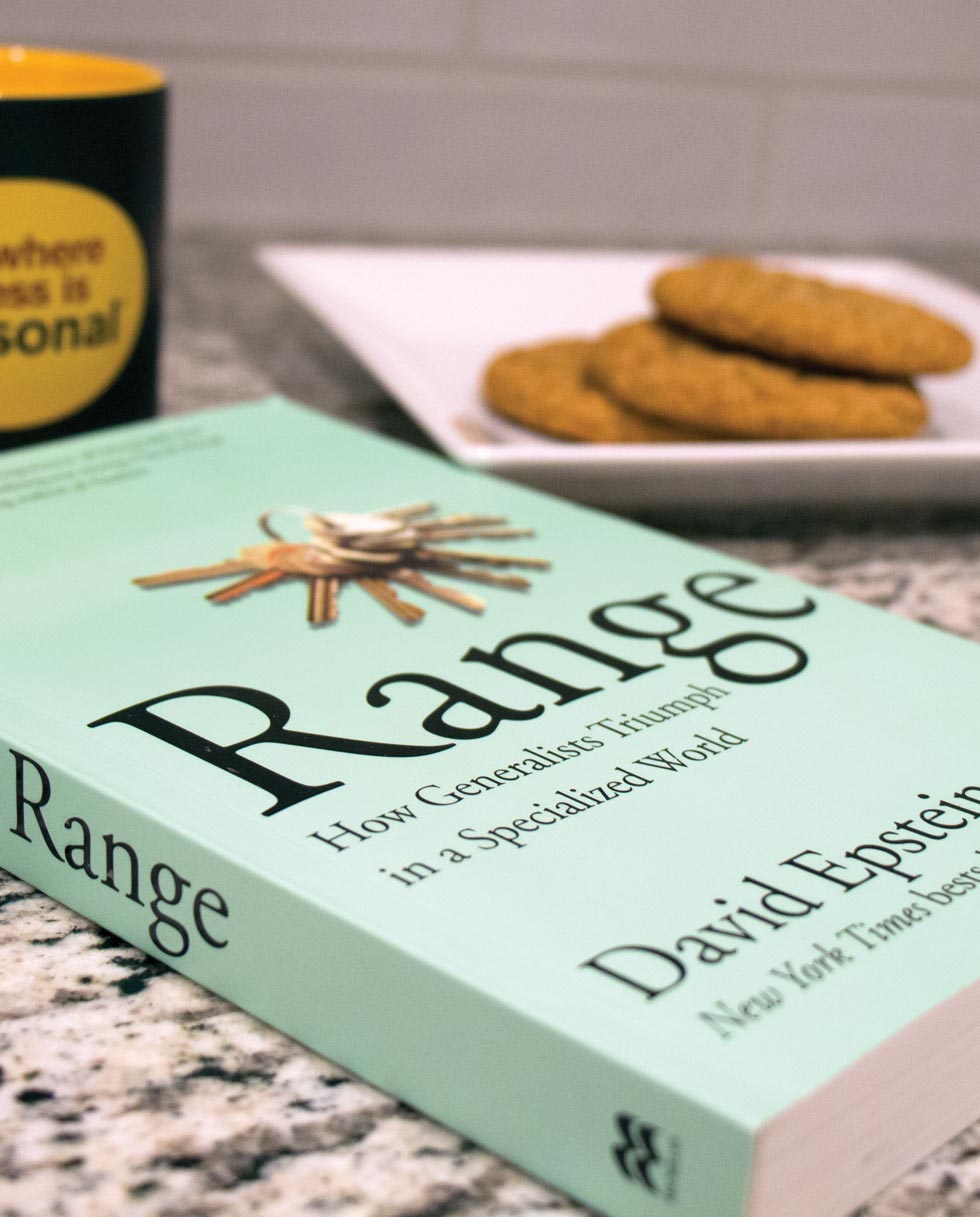
“Creating a new invention involves looking at something differently than anyone else has. This is done by people with a variety of skill sets,” says Alyssa Schott (BS Management/BA Business Sustainability ’19). “However, specialization is needed after the general new idea is formed. The specialists are needed to fix the bugs and have the knowledge to create a successful product.”
The COVID-19 pandemic illustrates not only the importance of specialized knowledge but also the ability to adapt. “ASU has the state’s first saliva-based testing lab. We received FDA emergency approval and used a network of 3D printers to start doing the nasal swab test,” explains W. P. Carey Dean Amy Hillman. “It is unclear how ASU’s testing lab will turn out because there is still so much uncertainty. One thing is for sure, adaptability has never been more important. These are the skills that are going to come from generalists.”
ALL THINGS WPC
he team of Samuel Atta Gyan, Lois Andoh, Samuel Togodui, and Asie Wadee (MS-GL ’20) was one of the top two winners of this year’s Rutgers TEN Plus Supply Chain Innovation Challenge. The foursome shared a $5,000 cash prize.
All four members of the team hail from Ghana and arrived at ASU through the Mastercard Foundation Scholars program, which strives to support young scholars from Africa. These students embody leadership and seek to foster a positive impact on their communities.
Although this year’s competition — an extension of the Rutgers TEN Plus Supply Chain Case Challenge, hosted by the Rutgers Business School supply chain management department — was just as competitive, it was slightly different from previous years because of COVID-19.
This year, the Rutgers leadership team decided to award the winners based on their performance during the virtual first round. This event highlighted adaptability within higher education during an unprecedented time in history. Teams presented ideas to add value for electronic manufacturer BetaWare’s customers.

SEPT. 17
Join Kate Eaton to learn about service recovery as a path toward better customer relationships and offerings.
OCT. 22
A special event honoring 2020 Executive of the Year Christian Koch, president and CEO of the Carlisle Companies. Rescheduled from April 2020.
OCT. 24
Join Bart Hobijn to hear about the macroeconomic impact of the COVID-19 recession and the outlook going forward.
NOV. 3
Hear from Jerry Coleman, co-founder and former co-CEO of Offerpad — the recipient of this year’s ECP Spirit of Enterprise Award.
DEC. 1
JAN. 13
Learn from the president and CEO of Verra Mobility.
JAN. 19
Fresh supply chain insights from Oke Agedoke.
hen COVID-19 began accelerating across the country in March, the nation shut down in many ways.
But for those in the W. P. Carey community, the pandemic was a chance to step up. Using skills honed in the classroom and principles that have helped them succeed in business and beyond, they’ve found ways to support frontline workers, hungry families, and first-time homeschool teachers and distance learners.
The country and the world are facing the challenge of a lifetime, and these W. P. Carey and ASU students, alumni, and faculty members have risen to the challenge.
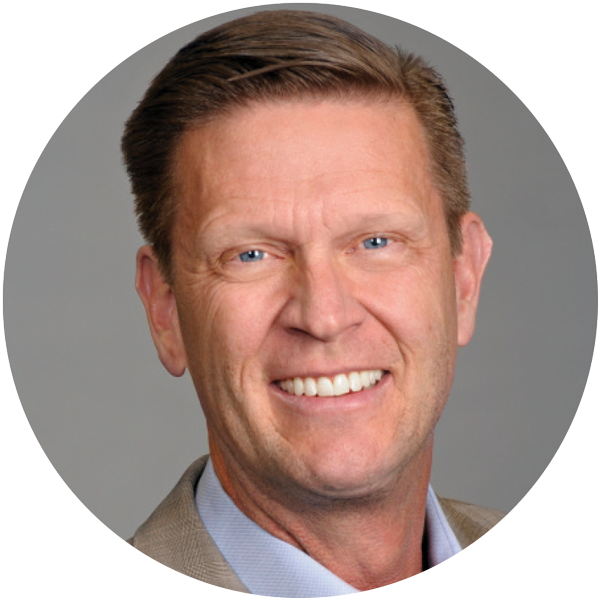 Share what you know
Share what you knowGreg Dawson, a clinical professor of accountancy, is praised on student-written review sites as “respected,” “caring,” and “hilarious.”
But Dawson admits that when COVID-19 closed campus, he was feeling more than a little helpless. “I joke that if I became shipwrecked on an island with other people, I’d be the first one eaten because I don’t bring any practical skills to the table,” he says. “I wasn’t someone on the front lines, like medical workers or restaurant workers.”
 Share what you know
Share what you knowGreg Dawson, a clinical professor of accountancy, is praised on student-written review sites as “respected,” “caring,” and “hilarious.”
But Dawson admits that when COVID-19 closed campus, he was feeling more than a little helpless. “I joke that if I became shipwrecked on an island with other people, I’d be the first one eaten because I don’t bring any practical skills to the table,” he says. “I wasn’t someone on the front lines, like medical workers or restaurant workers.”
b-schools more
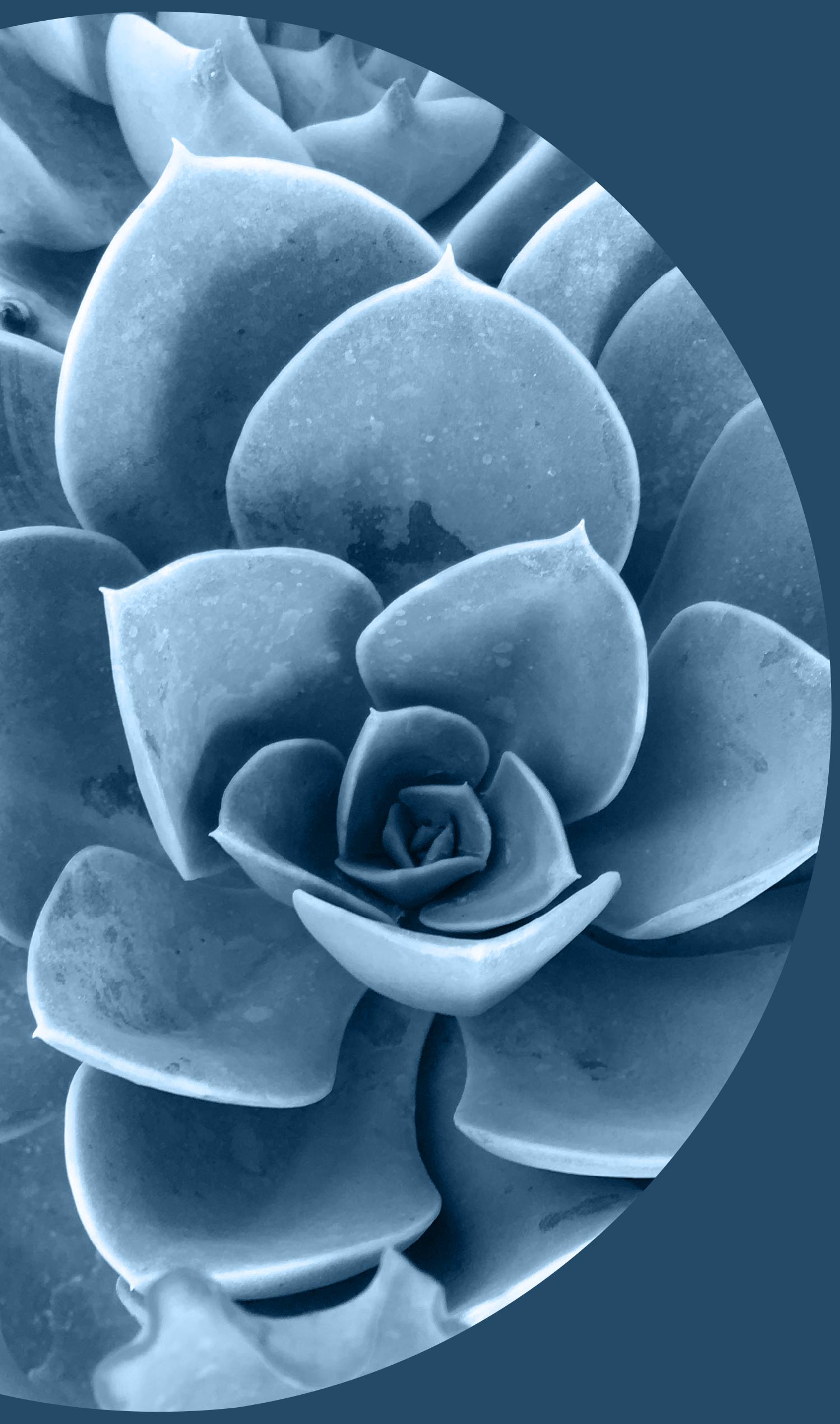
ave you ever broken your arm? Or hurt a hand, wrist, or finger?
These types of injuries often serve as a kind of rude awakening. Before they happened, simple activities such as writing, typing, and scratching your head required no thought. You did them naturally. After an injury, you puzzle over movements that once came unconsciously, attempting to avoid putting weight on a bone or joint that is temporarily incapable of bearing it. Each move threatens a pang of discomfort — or, worse, reinjury.
So, you continue gradually, carefully. You figure out the shortest path between two points. You rethink the things that once came so naturally, relearning with each cautious step.
That’s how things felt for most of us in the spring.
Whether it was fumbling with Zoom, postponing your wedding, losing 70% of the business, or getting laid off from work, the start of spring probably didn’t go as planned. Since then, we’ve grasped Zoom — except for the occasional mute slipup — married online, pivoted our business, or took online summer courses to expand our skills while we had time on our hands. Despite these challenges and necessary changes, we don’t know how the fall and beyond will unfold.
But as these faculty and staff from ASU’s W. P. Carey School of Business will tell you, they’ve been preparing for the coming year in an environment of uncertainty. While traditional approaches to learning were already becoming irrelevant amid the era of the Fourth Industrial Revolution, COVID-19 accelerated it. As their experience shows, W. P. Carey programs innovated years ago and have continued to evolve; now, the crisis is taking them to a new realm of teaching and learning.
b-schools more

ave you ever broken your arm? Or hurt a hand, wrist, or finger?
These types of injuries often serve as a kind of rude awakening. Before they happened, simple activities such as writing, typing, and scratching your head required no thought. You did them naturally. After an injury, you puzzle over movements that once came unconsciously, attempting to avoid putting weight on a bone or joint that is temporarily incapable of bearing it. Each move threatens a pang of discomfort — or, worse, reinjury.
So, you continue gradually, carefully. You figure out the shortest path between two points. You rethink the things that once came so naturally, relearning with each cautious step.
That’s how things felt for most of us in the spring.
Whether it was fumbling with Zoom, postponing your wedding, losing 70% of the business, or getting laid off from work, the start of spring probably didn’t go as planned. Since then, we’ve grasped Zoom — except for the occasional mute slipup — married online, pivoted our business, or took online summer courses to expand our skills while we had time on our hands. Despite these challenges and necessary changes, we don’t know how the fall and beyond will unfold.
But as these faculty and staff from ASU’s W. P. Carey School of Business will tell you, they’ve been preparing for the coming year in an environment of uncertainty. While traditional approaches to learning were already becoming irrelevant amid the era of the Fourth Industrial Revolution, COVID-19 accelerated it. As their experience shows, W. P. Carey programs innovated years ago and have continued to evolve; now, the crisis is taking them to a new realm of teaching and learning.
s students across the country left classrooms and opened laptops last spring, there were not a lot of clear answers about what this new remote format meant for learning, coursework, and students and faculty expectations. Now, with a little more time to plan and a lot of endurance, ASU has delineated between two main formats for learning, full immersion synchronous and digital immersion, to meet diverse student demands. While the two have some things in common, each modality fills a different, specific need.
Full immersion synchronous learning, also called ASU Sync, means students can attend physically in classrooms on campus (abiding by CDC guidelines), while other students join that same class remotely. Or, if self-quarantine is necessary, all students will attend remotely. In this format, students are still able to interact with each other and faculty. There is more structure, because a full immersion synchronous class is held at specific times, and live video and chat mean students can ask questions in real time.
While full immersion synchronous learning became a necessity in the wake of the COVID-19 pandemic, ASU President Michael Crow acknowledges its importance in several other areas including student retention. “It used to be that if you got sick for, say, five weeks in the fall semester of your sophomore [second] year in an American college, you have a 90% chance of dropping out and never going back,” he says. “Full immersion synchronous learning allows a student who is ill or has a family emergency to stay connected from afar.”
efore the COVID-19 pandemic, quarterly Teaching & Learning workshops helped W. P. Carey faculty connect from across the school to reinforce excellence in classroom practices. They shared the best methods to engage students and tips and tricks for using technology in the classroom.
Amid COVID-19-related school disruptions, Teaching & Learning workshops have become even more crucial as faculty have had to lean on one another to learn how to engage strategically with students online.
Matt Sopha, a clinical associate professor of information systems, shares ways faculty can connect and collaborate with students online through Slack, a collaborative workspace for teams.
“It’s easy to write this off as another chat app,” Sopha says. “It’s not.” The communication platform allows users to organize chat rooms by topic, create private groups, and send direct messages, and it’s particularly useful for remote learning and teamwork.
nstead of overanalyzing your next career move, Scott Moffitt (BS Finance ’88), president of the $1.4 billion coffee creamer and beverage division of Danone North America, suggests you “think ‘future back’ — that is, think about where you want to end up at retirement and realize how much time you’ve got to find your way there.”
Moffitt knows from experience that the best path to business learning and success is not necessarily the straightest one. He came to ASU to study computer systems engineering but ended up majoring in finance. Upon graduation, he says, “I aspired to work on Wall Street. The bright lights and big city attracted me. I thought the bigger the arena, the better.”
But Moffitt was offered a management training position at Norwest Bank (later acquired by Wells Fargo) in Minneapolis — a far cry from the Big Apple, but which turned out to be a “fantastic experience” he couldn’t pass up.
Still, finance itself turned out to be a starting point. Moffitt realized this when he visited one of the bank’s clients, General Mills. He had lunch with the assistant treasurer in Minneapolis and happened to walk through the marketing department, which changed the trajectory of his career.
“They looked like they were doing meaningful work, work that impacted consumers’ lives, and having fun while doing it,” recalls Moffitt. He met a marketer there who explained more about their marketing operation and realized this was what he wanted to do.
(BS Finance ’88)
(BS Finance ’88)
nstead of overanalyzing your next career move, Scott Moffitt (BS Finance ’88), president of the $1.4 billion coffee creamer and beverage division of Danone North America, suggests you “think ‘future back’ — that is, think about where you want to end up at retirement and realize how much time you’ve got to find your way there.”
Moffitt knows from experience that the best path to business learning and success is not necessarily the straightest one. He came to ASU to study computer systems engineering but ended up majoring in finance. Upon graduation, he says, “I aspired to work on Wall Street. The bright lights and big city attracted me. I thought the bigger the arena, the better.”
But Moffitt was offered a management training position at Norwest Bank (later acquired by Wells Fargo) in Minneapolis — a far cry from the Big Apple, but which turned out to be a “fantastic experience” he couldn’t pass up.
Still, finance itself turned out to be a starting point. Moffitt realized this when he visited one of the bank’s clients, General Mills. He had lunch with the assistant treasurer in Minneapolis and happened to walk through the marketing department, which changed the trajectory of his career.
“They looked like they were doing meaningful work, work that impacted consumers’ lives, and having fun while doing it,” recalls Moffitt. He met a marketer there who explained more about their marketing operation and realized this was what he wanted to do.
CRUNCHING THE NUMBERS WPC
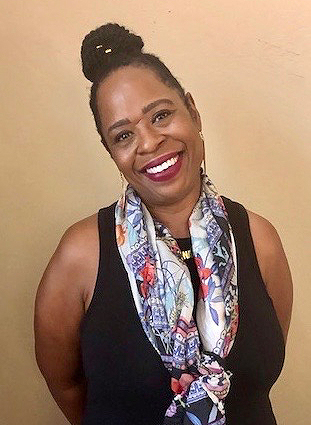
hen W. P. Carey students take an online class, Instructional Designer Senior Ada Malcioln Martin is behind the scenes. Along with five other instructional designers at the school, she assists faculty with creating, building, and maintaining content for online course delivery.
Martin and her fellow instructional designers play a crucial role in making sure the tools students use to learn are practical and easy to understand. They look for gaps in knowledge and come up with ways to fill them, whether through games, tutorials, or articles. They also collaborate with faculty to develop curriculum and test learning to make sure students are ready for the next challenge. Because instructional designers are experts in technology and education, they must stay up to date on changes in both fields.
Martin began her career in higher education during the mid- to late 1990s, when online education in the United States was in its infancy and online enrollment was a fraction of what it is today. Online courses have quadrupled in the past 15 years and are growing even more quickly around the world. Among current college students (undergrad) who were enrolled at four-year institutions before March 1 and COVID-19, 97% have switched to online instruction.
hen most researchers talk about work-life balance, they talk as though these two spheres are separate,” explains Blake Ashforth, ASU Regents Professor of management and Horace Steele Arizona Heritage Chair. As many of us know firsthand, though, this isn’t the case. “Humans have rich and overlapping identities at home, with their faith communities, at work, and more. The management field needs new ways of looking at the intersections of all our identities,” Ashforth says.
A new paper by Ashforth and colleagues Wayne S. Crawford, assistant professor at University of Texas at Arlington, and Merideth J. Thompson, associate professor at Utah State University, seeks to enrich the conversation. The authors propose a new model in the Academy of Management Review called “work-life events theory,” which helps explain how dual-earner couples handle shock events in their life. A shock event is something that is disruptive, rare, a priority, and requires an influx of the couple’s resources, such as time or money. An example of a shock event could be a major illness or loss of a job, but it could also be something positive, such as a promotion that requires relocation.
When one of these shock events happens, couples try to navigate through them together. “One thing we emphasize is there are three actors involved,” Ashforth says, “Partner A, Partner B, but then also the relationship itself is something that has its own particular needs and dynamics.” Ashforth and his co-authors stress that this point is important because just as both members of a couple have their own individual identities and histories, the couple as a unit has unique goals and a history that affects how they navigate a shock event.
Thus, Ashforth and his colleagues suggest there are two levels to how dual-earner couples manage a shock event: The first is individually, considering their own identities and goals, and then the couple comes together to make sense of the shock event and respond to it. Together, this process creates the researchers’ new work-life events theory.
hen most researchers talk about work-life balance, they talk as though these two spheres are separate,” explains Blake Ashforth, ASU Regents Professor of management and Horace Steele Arizona Heritage Chair. As many of us know firsthand, though, this isn’t the case. “Humans have rich and overlapping identities at home, with their faith communities, at work, and more. The management field needs new ways of looking at the intersections of all our identities,” Ashforth says.
A new paper by Ashforth and colleagues Wayne S. Crawford, assistant professor at University of Texas at Arlington, and Merideth J. Thompson, associate professor at Utah State University, seeks to enrich the conversation. The authors propose a new model in the Academy of Management Review called “work-life events theory,” which helps explain how dual-earner couples handle shock events in their life. A shock event is something that is disruptive, rare, a priority, and requires an influx of the couple’s resources, such as time or money. An example of a shock event could be a major illness or loss of a job, but it could also be something positive, such as a promotion that requires relocation.
When one of these shock events happens, couples try to navigate through them together. “One thing we emphasize is there are three actors involved,” Ashforth says, “Partner A, Partner B, but then also the relationship itself is something that has its own particular needs and dynamics.” Ashforth and his co-authors stress that this point is important because just as both members of a couple have their own individual identities and histories, the couple as a unit has unique goals and a history that affects how they navigate a shock event.
Thus, Ashforth and his colleagues suggest there are two levels to how dual-earner couples manage a shock event: The first is individually, considering their own identities and goals, and then the couple comes together to make sense of the shock event and respond to it. Together, this process creates the researchers’ new work-life events theory.
ou may not realize it, but at this very moment, you’re riding an escalator — a wage escalator, that is. How quickly you rise to the top determines how much your wages will increase throughout your career. And your race and gender can make a big difference in the quality of your ride.
In a study recently published in Economic Letters, Professor of Economics Bart Hobijn, professors at the University of Minnesota, and the Federal Reserve Bank of San Francisco compared early- to midcareer wage growth among Black men, Black women, white men, and white women.
Using data from the U.S. Census Bureau’s Current Population Survey, which the U.S. Bureau of Labor Statistics uses to measure the unemployment rate and estimate income inequality, the researchers constructed career wage profiles to illustrate how wage growth differs for each of these groups over 15 years. And while Black workers, in general, showed slower wage growth than their white counterparts, Black men’s wages fared especially poorly when compared with white men’s wages.
All aboard the wage escalator
To explain these wage gaps, Hobijn and his colleagues use the metaphor of a wage escalator. How fast you go up the escalator determines how quickly, and how much, your wages will increase throughout your career. But the speed of your ascent depends on many factors.
ou may not realize it, but at this very moment, you’re riding an escalator — a wage escalator, that is. How quickly you rise to the top determines how much your wages will increase throughout your career. And your race and gender can make a big difference in the quality of your ride.
In a study recently published in Economic Letters, Professor of Economics Bart Hobijn, professors at the University of Minnesota, and the Federal Reserve Bank of San Francisco compared early- to midcareer wage growth among Black men, Black women, white men, and white women.
Using data from the U.S. Census Bureau’s Current Population Survey, which the U.S. Bureau of Labor Statistics uses to measure the unemployment rate and estimate income inequality, the researchers constructed career wage profiles to illustrate how wage growth differs for each of these groups over 15 years. And while Black workers, in general, showed slower wage growth than their white counterparts, Black men’s wages fared especially poorly when compared with white men’s wages.
All aboard the wage escalator
To explain these wage gaps, Hobijn and his colleagues use the metaphor of a wage escalator. How fast you go up the escalator determines how quickly, and how much, your wages will increase throughout your career. But the speed of your ascent depends on many factors.
f you’ve ever asked people you know for their thoughts about a future purchase, you’re not alone. One study from Nielsen researchers found that 92% of survey respondents trust product endorsements from family and friends.
Folks trust strangers, too — a 2018 survey reported that 82% of consumers read online reviews.
Does that translate into more sales for companies that offer online review functionality on their retail websites? It does, says Assistant Professor of Information Systems Ni Huang, who tested an in-site review system on customers of an e-commerce retailer. She found that the system served as an effective word-of-mouth (WOM) marketing tool that boosted sales and profits once customers saw a critical number of reviews on a product page.
Online review systems may be a standard now, but even Huang admits they can have unintended consequences.
On the plus side, such systems allow companies to gather customer feedback and provide additional product information, Huang says. Review systems also facilitate WOM marketing because customers share their experiences and preferences with others online. Those opinions can be both positive and negative, though, and previous research has shown that “negative WOM in the system can outright damage a product or website’s reputation,” Huang and her research colleagues wrote in a paper covering their experiment.
The reason is “social learning,” which holds that people learn by watching other people. Social learning can boost or depress sales, and its impact isn’t limited to the risk of negative comments. It’s also related to the number of comments themselves.
“The quantity of the comments on your product pages affects whether people choose to purchase or not,” Huang says. If the customer sees only a few comments in your word-of-mouth system, “the customer might infer that the product is unpopular,” she adds. If that product is unpopular, maybe it’s unworthy, too, and would-be customers may shy away from buying it.
f you’ve ever asked people you know for their thoughts about a future purchase, you’re not alone. One study from Nielsen researchers found that 92% of survey respondents trust product endorsements from family and friends.
Folks trust strangers, too — a 2018 survey reported that 82% of consumers read online reviews.
Does that translate into more sales for companies that offer online review functionality on their retail websites? It does, says Assistant Professor of Information Systems Ni Huang, who tested an in-site review system on customers of an e-commerce retailer. She found that the system served as an effective word-of-mouth (WOM) marketing tool that boosted sales and profits once customers saw a critical number of reviews on a product page.
Online review systems may be a standard now, but even Huang admits they can have unintended consequences.
On the plus side, such systems allow companies to gather customer feedback and provide additional product information, Huang says. Review systems also facilitate WOM marketing because customers share their experiences and preferences with others online. Those opinions can be both positive and negative, though, and previous research has shown that “negative WOM in the system can outright damage a product or website’s reputation,” Huang and her research colleagues wrote in a paper covering their experiment.
The reason is “social learning,” which holds that people learn by watching other people. Social learning can boost or depress sales, and its impact isn’t limited to the risk of negative comments. It’s also related to the number of comments themselves.
“The quantity of the comments on your product pages affects whether people choose to purchase or not,” Huang says. If the customer sees only a few comments in your word-of-mouth system, “the customer might infer that the product is unpopular,” she adds. If that product is unpopular, maybe it’s unworthy, too, and would-be customers may shy away from buying it.

odd Lemay remembers longing for snowless days. The weather constricted the Maine native in ways others couldn’t comprehend. That wasn’t all; steps robbed him of his freedom. Beaches did the same.
“Every house, every apartment, even restaurants — they all have steps in Maine,” he says.
Lemay was born with osteogenesis imperfecta, a brittle bone disease that has led him to use a wheelchair for most of his life. He sometimes walked as a child, but that would only lead to more broken bones and more surgeries. He was tired of it in his teens. “I decided it’s not worth going through all the surgeries just so that I can maybe walk 20 feet on my own,” he says.
Patti Gentry (BS Business Administration ’72) joined commercial real estate services company JLL in Phoenix with three decades of commercial real estate experience, including specific expertise in the health care and medical office space. As the senior vice president, she’ll guide the expansion of the company’s local health care platform. Gentry is also president of the Burns Family Foundation, chairperson of the St. Joseph’s Hospital and Medical Center Community Board, and the first-ever female chairperson at Barrow Neurological Institute. Additionally, she’s a member of Scottsdale Leadership, Women Business Leaders of Healthcare, the ASU W. P. Carey School of Business Dean’s Council, and a lifetime member of the Sun Angel Foundation, supporting academic and athletic excellence within ASU’s women’s sports.
Ira Ehrlich (BS Accountancy ’81), an elementary STEM instructor at Quarry Lane School in Dublin, Calif., says he enjoys empowering young and talented individuals who may become tomorrow’s leaders and help change the world.
Rick Dircks (MBA ’87) is the executive vice president of Dircks Moving & Logistics, Arizona’s largest and most diversified moving company and the fourth-largest agent in the U.S. for Mayflower Van Lines. Dircks is actively involved in the community and, in addition to sitting on numerous boards, was named the Small Business Person of the Year by the Greater Phoenix Chamber of Commerce and is a recipient of ASU’s Arizona Business Leadership Award. As a passionate Sun Devil, Dircks has been a longtime member of the ASU President’s Club and a sponsor of Sun Devil Athletics. “My goal is to let Sun Devils know about ASU’s success in rankings of excellence and the accomplishments of its students who continue to earn prestigious national and international scholarships,” Dircks says.
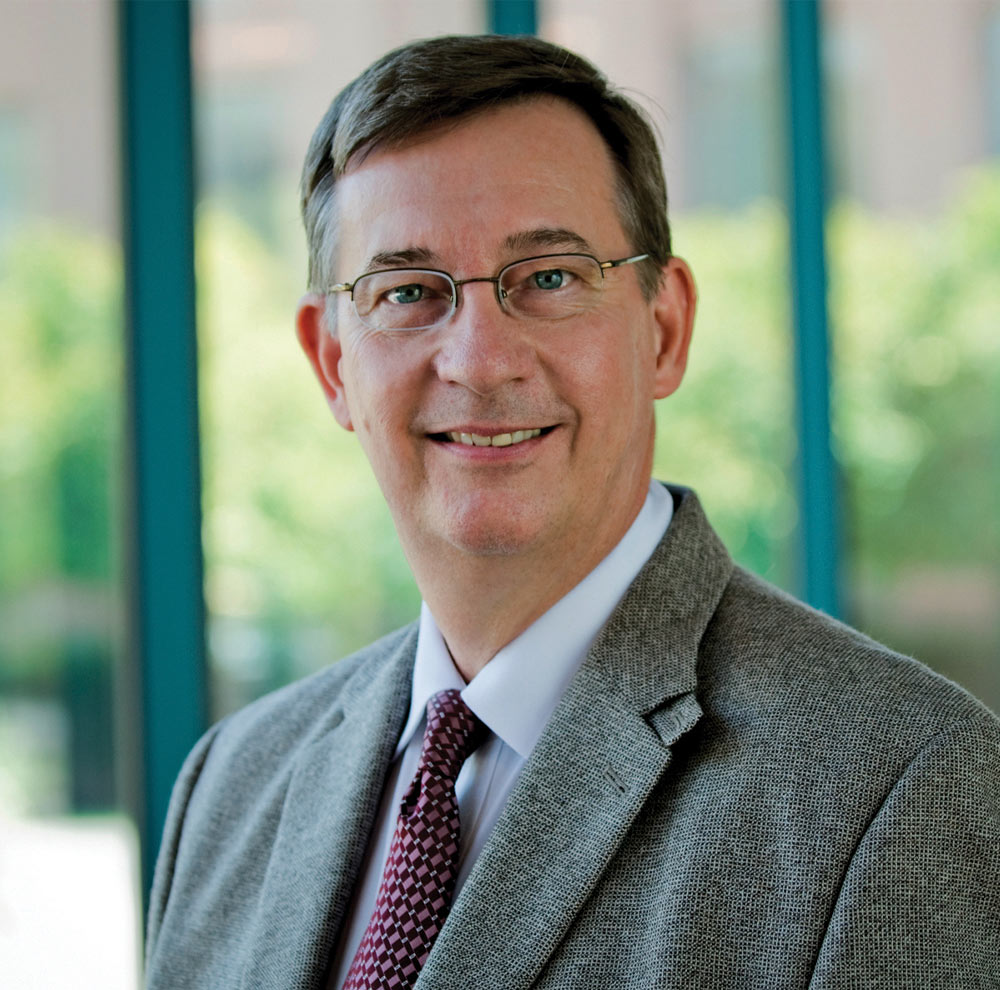
Professor K. Michael Goul — a passionate educator to thousands, a visionary researcher, and a mentor and friend to many — died of cancer March 19 at the age of 64.
Goul had been serving as the senior associate dean for faculty and research and as a professor of information systems at the W. P. Carey School. He was an affiliated faculty member for ASU’s Institute for Social Science Research and the Global Security Initiative, and also served on the Biodesign Institute’s internal advisory board.
Goul was recognized in 2016 with the Outstanding Leadership Award by the IEEE Computer Society Technical Committee on Services Computing.
Phil Calandra (MBA ’75) and his wife, Susan, of Foster City, California, have made a multiyear commitment to the Student Emergency Fund. “I know first-hand what a financial struggle it can be for a young person to fund an MBA. But I also know what a huge door opener and skills asset an MBA is throughout a career,” Calandra says. “By combining a family loan and a part-time tutoring job with the Sun Devil Football program, I covered my degree — but it wasn’t easy. I’m pleased to now give back, helping solve financial distress situations for current and future W. P. Carey students.”
This fund is dependent on regular contributions from alumni, parents, faculty, staff, and friends of the business school. Visit wpcarey.asu.edu/give to donate.
Andrew Charitan
BS Economics and Management
Kirwin Elmers
BS Economics and Management
Jew Song
BS Marketing and Advertising
1953
Gerald McGrath
BS Accounting
1954
Lloyd Fernandez
BS Marketing and Advertising
1960
Duane Arlen Mills
BA Business Administration
1969
Cyril Young
BS Business Administration
1976
Timothy Warfield
MBA
1978
Gregory N. Ashby
BS Accountancy
1979
James Hess
MBA
Robert Dean Kirkman
BS Finance
Dewey Lorenzo Bryce
BS Accounting
1983
Kathryn Schammel
BS Finance
1986
Victoria Sanchez
PhD Business Administration
1987
Evelyn Dorothy Driver
BS Finance
Holly Moskowitz Goldstone
MBA
1988
Robert Church
BS International Business
1990
Richard Bachman
BA Management
2002
Kevin Seward
MBA
2004
Gene Schmidt
BS Management
Andrew Charitan
BS Economics and Management
Kirwin Elmers
BS Economics and Management
Jew Song
BS Marketing and Advertising
1953
Gerald McGrath
BS Accounting
1954
Lloyd Fernandez
BS Marketing and Advertising
1960
Duane Arlen Mills
BA Business Administration
1969
Cyril Young
BS Business Administration
1976
Timothy Warfield
MBA
1978
Gregory N. Ashby
BS Accountancy
1979
James Hess
MBA
Robert Dean Kirkman
BS Finance
Dewey Lorenzo Bryce
BS Accounting
1983
Kathryn Schammel
BS Finance
1986
Victoria Sanchez
PhD Business Administration
1987
Evelyn Dorothy Driver
BS Finance
Holly Moskowitz Goldstone.
MBA
1988
Robert Church
BS International Business
1990
Richard Bachman
BA Management
2002
Kevin Seward
MBA
2004
Gene Schmidt
BS Management

ick Boggs (MBA ’11) was determined to create a great-tasting creamer that complemented his healthy lifestyle. The idea came to him about 10 years ago when he thought about dominant players in the creamer market like Coffee Mate.
“I like black coffee. I can drink it here and there, but I like to add a little flavor to it,” says Boggs, who’d tried using various flavored protein powders as healthy additions but “it would clump together and didn’t taste right.”
Though healthy alternatives existed, he couldn’t find exactly what he was looking for in the market. “I wanted to create a product that could improve the quality of life for others by providing a true functional benefit.”
That idea brewed while Boggs finished graduate school and gained work experience.
Business
Zodiac






